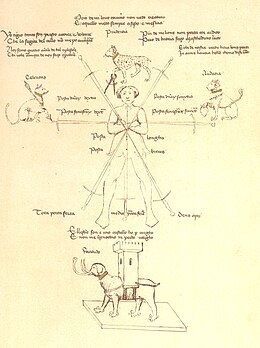
Back Esgrima italiana Spanish Scuola italiana di scherma Italian Итальянская школа фехтования Russian Італійська школа фехтування Ukrainian
 The sette spade Diagram from the Pisani facsimile of the Flos Duellatorum (fol. 17A). The four animals symbolize prudence (lynx), celerity (tiger), audacity (lion), and fortitude (elephant). | |
| Also known as | La Scuola Della Spada Italiana |
|---|---|
| Focus | Weaponry |
| Country of origin | Italy |
| Creator | Historical |
| Famous practitioners | Fiore dei Liberi, Filippo Vadi, Achille Marozzo, Antonio Manciolino, Angelo Viggiani, |
| Descendant arts | Modern fencing |
| Olympic sport | No |
The term Italian school of swordsmanship is used to describe the Italian style of fencing and edged-weapon combat from the time of the first extant Italian swordsmanship treatise (1409) to the days of classical fencing (up to 1900).
Although the weapons and the reason for their use changed dramatically throughout these five centuries, a few fundamental traits have remained constant in the Italian school. Some of these are the preference for certain guards, the preoccupation with time (or "tempo") in fencing as well as many of the defensive actions.
The Dardi school of fencing with the spada da lato was one of the influences of the early modern style of fencing.
© MMXXIII Rich X Search. We shall prevail. All rights reserved. Rich X Search